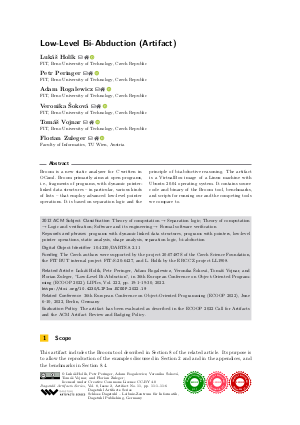Low-Level Bi-Abduction (Artifact)
Authors
Lukáš Holík  ,
Petr Peringer
,
Petr Peringer  ,
Adam Rogalewicz
,
Adam Rogalewicz  ,
Veronika Šoková
,
Veronika Šoková  ,
Tomáš Vojnar
,
Tomáš Vojnar  ,
Florian Zuleger
,
Florian Zuleger 
-
Part of:
Issue:
Special Issue of the 36th European Conference on Object-Oriented Programming (ECOOP 2022)
Part of: Volume: DARTS, Volume 8 (ECOOP 2022)
Part of: Conference: European Conference on Object-Oriented Programming (ECOOP)
Part of: Journal: Dagstuhl Artifacts Series (DARTS) - License:
 Creative Commons Attribution 4.0 International license
Creative Commons Attribution 4.0 International license
- Publication Date: 2022-06-23
Artifact Description

PDF
DARTS.8.2.11.pdf
- Filesize: 0.58 MB
- 6 pages
Document Identifiers
Subject Classification
ACM Subject Classification
- Theory of computation → Separation logic
- Theory of computation → Logic and verification
- Software and its engineering → Formal software verification
Keywords
- programs with dynamic linked data structures
- programs with pointers
- low-level pointer operations
- static analysis
- shape analysis
- separation logic
- bi-abduction
Metrics
- Access Statistics
-
Total Accesses (updated on a weekly basis)
0PDF Downloads0Metadata Views
Abstract
Broom is a new static analyzer for C written in OCaml. Broom primarily aims at open programs, i.e., fragments of programs, with dynamic pointer-linked data structures - in particular, various kinds of lists - that employ advanced low-level pointer operations. It is based on separation logic and the principle of bi-abductive reasoning. The artifact is a VirtualBox image of a Linux machine with Ubuntu 20.04 operating system. It contains source code and binary of the Broom tool, benchmarks, and scripts for running our and the competing tools we compare to.
Cite As Get BibTex
Lukáš Holík, Petr Peringer, Adam Rogalewicz, Veronika Šoková, Tomáš Vojnar, and Florian Zuleger. Low-Level Bi-Abduction (Artifact). In Special Issue of the 36th European Conference on Object-Oriented Programming (ECOOP 2022). Dagstuhl Artifacts Series (DARTS), Volume 8, Issue 2, pp. 11:1-11:6, Schloss Dagstuhl – Leibniz-Zentrum für Informatik (2022)
https://doi.org/10.4230/DARTS.8.2.11
BibTex
@Article{holik_et_al:DARTS.8.2.11,
author = {Hol{\'\i}k, Luk\'{a}\v{s} and Peringer, Petr and Rogalewicz, Adam and \v{S}okov\'{a}, Veronika and Vojnar, Tom\'{a}\v{s} and Zuleger, Florian},
title = {{Low-Level Bi-Abduction (Artifact)}},
pages = {11:1--11:6},
journal = {Dagstuhl Artifacts Series},
ISSN = {2509-8195},
year = {2022},
volume = {8},
number = {2},
editor = {Hol{\'\i}k, Luk\'{a}\v{s} and Peringer, Petr and Rogalewicz, Adam and \v{S}okov\'{a}, Veronika and Vojnar, Tom\'{a}\v{s} and Zuleger, Florian},
publisher = {Schloss Dagstuhl -- Leibniz-Zentrum f{\"u}r Informatik},
address = {Dagstuhl, Germany},
URL = {https://drops.dagstuhl.de/entities/document/10.4230/DARTS.8.2.11},
URN = {urn:nbn:de:0030-drops-162092},
doi = {10.4230/DARTS.8.2.11},
annote = {Keywords: programs with dynamic linked data structures, programs with pointers, low-level pointer operations, static analysis, shape analysis, separation logic, bi-abduction}
}
Author Details
Funding
The Czech authors were supported by the project 20-07487S of the Czech Science Foundation, the FIT BUT internal project FIT-S-20-6427, and L. Holík by the ERC.CZ project LL1908.
Artifact
DARTS-8-2-11-artifact-101f2587490f8f755abecd453e2c01d1.zip
(Filesize: 4.89 GB)
MD5 Sum:
101f2587490f8f755abecd453e2c01d1
(Get MD5 Sum)
Artifact Evaluation Policy
The artifact has been evaluated as described in the ECOOP 2022 Call for Artifacts and the ACM Artifact Review and Badging Policy
Related Article
- Lukáš Holík, Petr Peringer, Adam Rogalewicz, Veronika Šoková, Tomáš Vojnar, and Florian Zuleger, "Low-Level Bi-Abduction", in 36th European Conference on Object-Oriented Programming (ECOOP 2022), LIPIcs, Vol. 222, pp. 19:1-19:30, 2022. https://doi.org/10.4230/LIPIcs.ECOOP.2022.19
